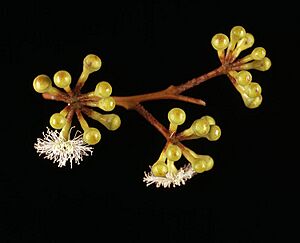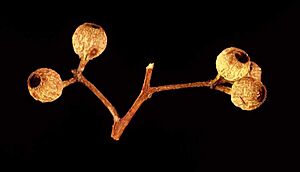Rate's tingle facts for kids
Quick facts for kids Rate's tingle |
|
|---|---|
 |
|
| Conservation status | |
| Scientific classification | |
| Genus: |
Eucalyptus
|
| Species: |
brevistylis
|
The Rate's tingle (scientific name: Eucalyptus brevistylis) is a special type of tree. It only grows in the south-west part of Western Australia. This means it is endemic to that area, found nowhere else in the world naturally.
This tree has bark that is rough and stringy. Its adult leaves are shaped like a spear. The flowers grow in groups of nine to thirteen, and they are white. After flowering, it produces round, woody fruits with a small opening.
Contents
What Does Rate's Tingle Look Like?
The Rate's tingle is a tall tree. It usually grows to be about 25 to 50 metres (82 to 164 ft) high. It has a special woody swelling at its base called a lignotuber. This helps the tree regrow if it gets damaged by fire.
Its Bark and Leaves
The bark of the Rate's tingle is greyish to reddish-brown. It feels rough and stringy. Sometimes, the outer layer of bark can be papery.
Young plants and new shoots have different leaves. These leaves are egg-shaped or heart-shaped. They are 40–70 mm (2–3 in) long and 25–60 mm (1–2 in) wide. They are green on top and lighter underneath. All these young leaves have a stalk, called a petiole.
Adult leaves are thin and shaped like a spear, or slightly curved. They are 53–90 mm (2–4 in) long and 10–30 mm (0.4–1 in) wide. Each adult leaf also has a petiole, which is 10–20 mm (0.4–0.8 in) long. The top and bottom sides of the adult leaves are different colors.
Flowers and Fruit
The flower buds of the Rate's tingle grow in groups. There are usually nine, eleven, or thirteen buds in each group. These groups are on a stalk called a peduncle, which is 7–14 mm (0.3–0.6 in) long. Each individual bud has its own small stalk, called a pedicel, about 4–7 mm (0.2–0.3 in) long.
When the buds are ready, they are oval or almost perfectly round. They are about 3 mm (0.12 in) long and wide. The top part of the bud, called the operculum, is rounded.
Rate's tingle trees flower at different times of the year. They can bloom between January and February, or from April to November. Their flowers are white.
After the flowers, the tree produces fruit. The fruit is a woody, almost round capsule. It is 6–10 mm (0.24–0.39 in) long and 6–9 mm (0.24–0.35 in) wide. It has a small opening where the seeds can escape.
How Rate's Tingle Got Its Name
The scientific name Eucalyptus brevistylis was first given to this tree in 1974. A scientist named Ian Brooker described it after a sample was collected near Walpole by Bruce Maslin.
The second part of its scientific name, brevistylis, comes from two Latin words. Brevis means "short," and -stylis means "having a style". This refers to a short part inside the flower of this tree.
The common name "Rate's tingle" honors a forester named Jack Rate. He worked hard to show that this tree was a unique species, even though it was often confused with other "tingle" trees. The name "tingle" or "tingle tingle" is believed to come from the Aboriginal people of the area.
Where Rate's Tingle Lives
Rate's tingle trees grow in wet forests. You can find them near the town of Walpole in Western Australia. For a long time, people thought Rate's tingle was the same as two other "tingle" species: the red tingle (E. jacksonii) and the yellow tingle (E. guilfoylei).
Rate's tingle and red tingle are very similar trees. They are closely related and can both live for a very long time, up to 400 years!
Protecting Rate's Tingle
The Government of Western Australia's Department of Parks and Wildlife keeps track of plants and animals. They have classified Eucalyptus brevistylis as "Priority Four".
This means that Rate's tingle is considered rare or almost threatened. It's important to protect these special trees so they can continue to grow in their natural home.




